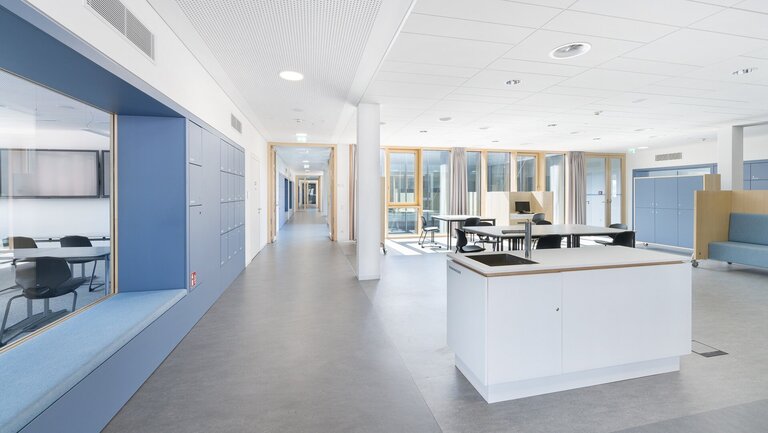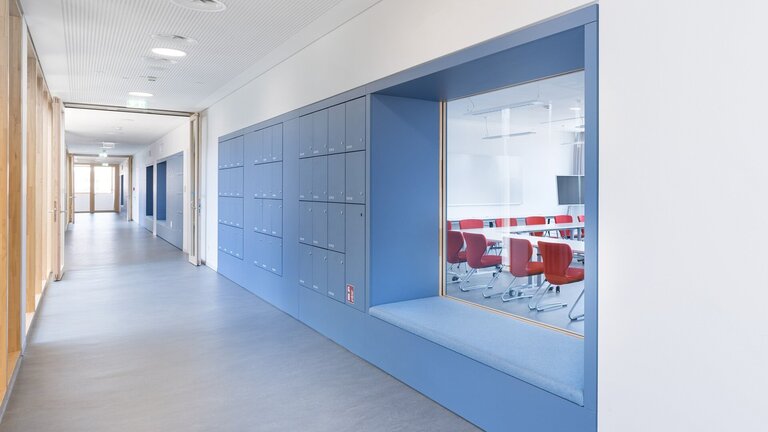Kempten, Germany, July 6, 2023. There has been a shortage of space in the vocational school center in Kempten for many years now. This will change soon: the special-purpose association ‘Vocational School Center’ plans to invest around 134 million euros until 2028 in order to create room for 6,000 school students, 320 teachers and administration. In addition, the indoor space will be redesigned as to comply with state-of-the-art teaching standards. In addition to extensive refurbishment work, the construction project also included an extension building which was completed last September. Stuttgart-based Drees & Sommer, a consulting company that specializes in the construction and real estate sector, supports the City of Kempten and the special-purpose association in this project.
The first milestone is ready: The extension building of the vocational and secondary technical college (Fachoberschule und Berufsoberschule, FOS-BOS) was completed on schedule and within the budget in September 2022 – in spite of the current material shortages and delivery problems. The building provides space for 35 classrooms and ten technical rooms. It is now also possible to redistribute rooms and to reorganize room functions, and thus avoid the need to send students to neighboring vocational schools for some courses. At the same time, the building also includes a cafeteria designed for about 300 persons which can be used as a rest and recreation area by the 720 students.
Modern Learning Environment in Energy-Saving Building
The new extension building is thus a central element in the design of a modern campus which encompasses the whole school complex – the three vocational schools, the vocational and secondary technical college (FOS-BOS), the commercial school, the technical school, three caretaker buildings, a sports hall and the adjacent vocational education and technology center of the Swabian Chamber of Trades (Handwerkskammer). The extension building was designed based on the learning cluster principle. The architecture follows an organizational concept which transcends the traditional division into separate classes. A cluster integrates the learning and teaching classrooms into a single environment which includes the associated differentiation, rest and recreation areas. The new building is thus a spatial reaction to the educational requirements and creates additional areas for creative exchange and free learning. Another feature is the very high energy efficiency of the building. It meets the Efficient House 55 standard set by the German Reconstruction Loan Bank (KfW-Effizienzhaus 55), which means that it has very low energy consumption and thus fulfills the sustainability goals.
Building in Existing Contexts Trumps New Construction
The decision to carry out general refurbishment and extension of the school buildings was preceded by a lively discussion about the advantages and disadvantages of refurbishing existing structures or rebuilding the whole complex. ‘The first thing we investigated in this discussion was whether the existing buildings are actually sufficient for the new spatial requirements. After our positive evaluation, we then examined the structural condition of the existing buildings and the resulting need for refurbishment. Then we compared the investment costs for refurbishment with the costs of a comparable new building,’ says project manager Thomas Rückert, who is responsible for the construction project at Drees & Sommer. This appraisal showed that the load-bearing structure of the existing building had originally been planned and implemented in a forward-looking way, so it offered a high degree of flexibility in its structure and permitted a far-reaching redesign of the floor plans. By renewing the facades, the existing building could even be brought up to an energy efficiency standard which is equivalent to a new building. Even taking into account the demolition work which is necessary in any refurbishment, the cost comparison came out in favor of a general refurbishment. ‘A complete reconstruction of the school complex would have cost 30 percent more.
Therefore, and also for sustainability reasons, we decided on general refurbishment and the addition of an extension building,’ explains Eberhard Mangold, former Managing Director of the special-purpose association.
Drees & Sommer’s expert Dr.-Ing. Björn Nohe comments: ‘Existing buildings are responsible for around 40 percent of the global CO2 emissions. Refurbished and modernized buildings are of particular relevance for creating low-carbon and clean-energy systems. Continued use of existing buildings saves resources. To protect the climate, refurbishment of existing buildings is therefore increasingly the better choice.


